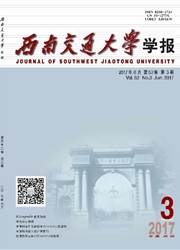

 中文摘要:
中文摘要:
针对自主定位信息错误或失效导致的列车完整性检测安全风险问题,在列车完整性检测问题进行分析的基础上,基于贝叶斯风险综合列车列首及列尾相对位置、相对速度及相对加速度信息,建立了列车完整性检测风险分析模型.该模型结合各项自主定位信息的检测失效概率及检测概率,分别计算了列车完整性检测虚警风险及失效风险.在此基础上,结合现场测试数据及仿真数据针对列车完整性检测风险分析方法进行了测试验证,结果表明:在列车完整场景中虚警风险结果为10~(-1.8),大于检测失效风险10~(-5.5);在列车非完整场景中,巡航和最大牵引条件下失效风险分别为10~(-1.8)和1,分别大于虚警风险10~(-4.5)和0,结果符合列车完整性真实状态下的检测风险.
 英文摘要:
英文摘要:
Autonomous-positioning information error and failure can lead to a safety risk in train integrity detection. In this study, the problem of train integrity detection, which determines whether a train remains intact in terms of relative position, velocity and acceleration, was investigated. A Bayesian risk-based train integrity detection risk analysis model was proposed to determine both the false-alarm rate and failure rate of autonomous-positioning information based train integrity detection. In this model, both the misdetection probability and failure probability of each autonomous-positioning information were applied to find the misdetection rate and false-alarm rate of train integrity detection. Then, a simulation based on field data was conducted to verify the train integrity detection risk analysis method. The results show that the risk of false alarms is 10 18, which is larger than the risk of misdetection (10_5'5) in the complete train scenario. In contrast, in the train break scenario, the risk of misdetection is 10 18 when cruising and 1 when accelerating, which are larger than the risk of false alarms (10 4 5 when cruising and 0 when accelerating) . The results conform to the train integrity states, indicating that the risk analysis model has sufficient capability to calculate the risk of autonomous-positioning information aided train integrity detection.
 同期刊论文项目
同期刊论文项目
 同项目期刊论文
同项目期刊论文
 期刊信息
期刊信息
